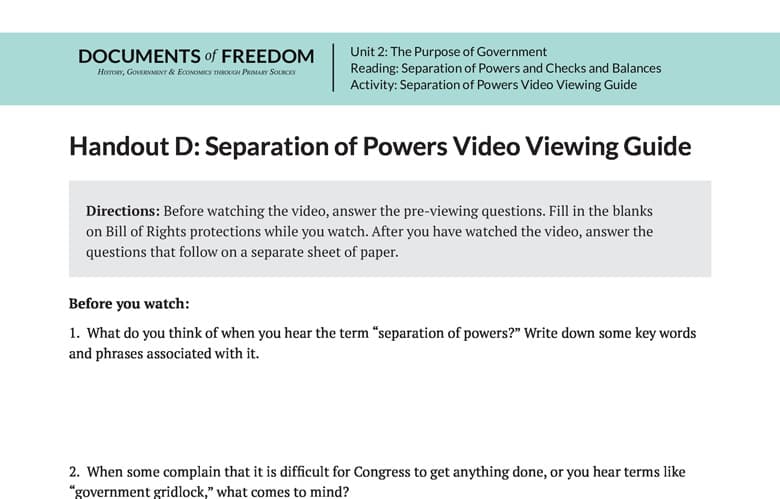Handout D: Separation of Powers Video Viewing Guide
Handout D: Separation of Powers Video Viewing Guide
Directions: Before watching the video, answer the pre-viewing questions. Fill in the blanks on Bill of Rights protections while you watch. After you have watched the video, answer the questions that follow on a separate sheet of paper.
Before you watch:
- What do you think of when you hear the term “separation of powers?” Write down some key words and phrases associated with it.
- When some complain that it is difficult for Congress to get anything done, or you hear terms like “government gridlock,” what comes to mind?
While you watch:
- The three branches of government are ____________________, which makes the law, ___________________, which carries out the law, and ________________________, which interprets the law.
- The Founders believed that for these powers to be concentrated in one person or branch, would be “the very definition of __________________.”
- Article I of the U.S. Constitution explains the powers and function of _____________________.
- Article II of the U.S. Constitution explains the powers and function of ____________________.
- Article III of the U.S. Constitution explains the powers and function of ___________________.
- In Federalist No. 51, James Madison wrote about the need to enable government to control the governed, as well as for government to control ____________________.
- The Constitution ensures that ____________________ is the most powerful branch of government.
After you watch:
- What does the principle of separation of powers mean?
- The video begins with Professor Munoz’s statement that the purpose of separation of powers is to “frustrate” government action. How would you put this in your own words?
- Why would the Founders have wanted to frustrate government action? Are those reasons still important today?
- How is James Madison’s plan for “ambition to counteract ambition” reflected in our system of separated powers?
- What does our system of separated powers with checks and balances reveal about the Founders’ understanding of human nature?

